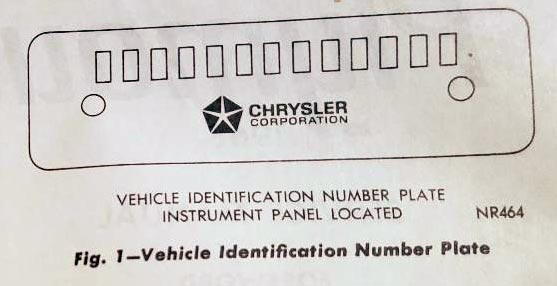VIN formats and definitions changed quite a bit from the original 1926 Fedco system to 1958; from 1959 on, they settled down quite a bit, to the point that we can have a single story for 1968 through 1980.

The first seven digits all had specific meanings, while the final six were meaningless and just used so every car had a unique number.
The carline letter had no real meaning; it had nothing to do with the platform.
Price class was relative to the car family; a high-end Valiant may have been cheaper than the cheapest Chrysler, but it would still justify H for High while the cheapest Chrysler might be L or M.
E - Economy
L - Low
M - Medium
H - High
P - Premium
Specialty letters were:
G - ?
K - Police
N - NYC taxi
S - Special
T - Taxi
O - Super Stock
X - Fast Top
There were only two choices, 2 and 4. Hatchbacks were not seen as “three doors” or five doors.”
1 - sedan
2 - B-pillared hardtop
3 - other hardtop
4 - hatchback
5 - 2-seat wagon
6 - 3-seat wagon (three rows of seats)
7 - convertible
9 - coupe / special
Engine definitions varied by year, and because there were so many engine packages, many codes were re-used. When there is a single engine for a code, we put the code and the engine on the same line rather than separating them. We apologize in advance for the lack of consistency.
A
(1966-69) 170 cid slant six
(1978-82) VW 1.7 four (Omni/Horizon)
B
(1966-1969) 225 slant six
(1970-74) 198 slant six
C
(1968-69) Slant 6 special order
(1970-80) 225, 1 bbl slant six
(1983-87) 2.2 (carbureted)
D
(1968-69) 273 V8
(1977-1979) 225 slant six (two-barrel)
E
(1966) 318-2 (trucks)
(1967) 273-4 (trucks)
(1970-1980) Special order slant six
F
(1966) 361 (any carb)
(1967-69) 318 two-barrel
G
(1966-69) 383 V8 two-barrel
(1970-1980) 318 standard
(1977-79) AMC 2.0 liter four-cylinder
H
(1966) 426 Hemi
(1967-69) 383 four-barrel
(1970-1973) 340 four-barrel
(1978-1980) 318 four-barrel
J
(1966) 440 V8
(1967-69) 426 Hemi
(1970-1971) 340 V8 “Six Pack”/6V
(1974-1979) 360 four-barrel
K
(1966) Special Order V8
(1967-1969) 440, four-barrel
(1971-1980) 360, two-barrel
L
(1967-69) 440 high performance 4V
(1970-71) 383 V8, standard
(1974-1980) 360 high performance (police only, 1979-80)
M
(1967) Special Order V8
(1969) 440-6
(1972-1976) 400 V8, standard
N
(1970-71) 383 V8, high performance
(1974-1978) 400 V8, 4 bbl carb
P
(1968-69) 340 V8 four-barrel (high performance)
(1972-1973) 400, four-barrel
(1974-1978) 400 V8, high performance
R: (1970-71) 426 Hemi
T:
(1970-1977) 440 V8, standard
U:
(1970-1978) 440 V8, high performance, including police
V: (1970-72) 440 V8 “Six-pack” / 6V
Z: (1970-1978) Special order V8 (Chrysler) or 401 V8 (AMC/Jeep)
6: 5.9 Cummins diesel
7: 318 LPG
This was the last digit of the year the car was made, which was a bit interesting since there’s no way to tell a 1970 car from a 1980 car by this part of the VIN.
The final position tells which plant the vehicles were made in. Over time, the list grew shorter as Hamtramck (Dodge Main), Lynch Road (Plymouth), and Los Angeles shut down. Wyoming was not in Wyoming; it was on Wyoming Road in Windsor, Ontario. Newark was in Delaware, and New Stanton was in Pennsylvania; built in the 1960s, it was sold to Volkswagen in 1978 and used to build Rabbits through 1987. At one point, plant personnel worked on building experimental postal vehicles, too.
(Text as of July 2023.) On these plants, Jefferson Avenue (Detroit), Belvidere (Illinois), and Windsor (Ontario) are all that remain today, and Belvidere has been shut down—perhaps temporarily, perhaps permanently. Jefferson Avenue makes Dodge Durangos; Windsor makes minivans but is soon to shut down for a complete renovation.
A - Lynch Road
B - Hamtramck
C - Jefferson
D - Belvidere
E - Los Angeles
F - Newark
G - St. Louis
H - New Stanton
P - Wyoming (Export)
R - Windsor
Record payments, loans for new cars; pricey used-car loans
Ram 4500, 5500 to be hit with 25% tariffs any day now… maybe
Mopar is rehiring to fill gaps left by Carlos Tavares
Copyright © 2021-2025 Zatz LLC • Chrysler / Mopar car stories and history.
YouTube • Editorial Guidelines • Videos
Tailfins Archive • MoTales on BlueSky